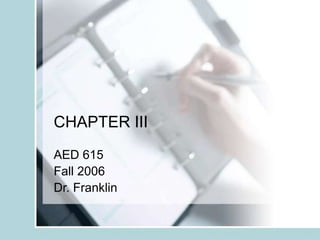
Chapter Three of Your Thesis.ppt
- 1. CHAPTER III AED 615 Fall 2006 Dr. Franklin
- 2. Chapter Overview • Chapter III is your thesis or project “recipe”. • You describe the steps you took to conduct your research or designed your project. • How detailed should it be? • The reader should have enough information that he/she could replicate your research with the same or similar population and arrive at the same results.
- 3. Re-Introduce the Reader • What is it again you are doing? – Purpose statement – Objective – A paragraph or two. • If the reader is interested in your methodology, he/she does not have to go back and forth through Chapter I to revisit the purpose and objectives.
- 4. Operational Framework • A visual representation of your steps to complete your research. • Construct a flow-chart with labels. • Make it a “figure” for your document. • Follow APA style for formatting a “figure”. • Be sure to have a narrative of your Operational Framework. • Tell the reader what occurs at each step.
- 5. Methodology • Type of research • Design • Population • Sample & sampling • Data gathering procedure • Data analysis procedure
- 6. Type of Research of Project • Descriptive • Experimental • Historical • Qualititative • Project (Curriculum design)
- 7. Design • Survey • Interrelationships studies • Developmental studies • Experimental studies
- 8. Surveys • School surveys (ie. Teachers, students, administrators, etc.) • Job analysis • Documentary analysis • Public opinion surveys • Community surveys
- 9. Interrelationships • Case studies • Causal comparative • Correlational studies
- 10. Developmental Studies • Growth studies • Trend studies • Model or system development
- 11. Experimental Studies • True experimental designs • Quasi-experimental designs • Pre-experimental designs
- 12. Data Gathering Procedures • Instrument development • Instrument description • Validity • Reliability • How will you get the information? – Self-administered survey questionnaire • Mailed • On-line • Ask in person • Ask over the phone
- 13. Data Gathering Procedures – Interview • Face to face • Open-ended • Follow-up questions – Observation (Ethnographic) • Watching • Listening • Recording • Non-participatory
- 14. Instrument Validation • Does the instrument measure the constructs we intend to measure? • Is the instrument reliable? – If we retest the subjects with the same instrument over a period of time (with no treatment in between), will they respond the same? – Is there inter-item reliability?
- 15. Instrument Validation • Is the instrument valid? • Does it measure what you want it to measure?
- 16. Population • Describe the subjects of your study. • What characteristics do they share that includes them in your population of interest? • Will you include all members of the population in your study? (Census). • What is the total number? (N)
- 17. Sampling • Is the size of our population so big that a census is too costly, or will take too much time? • Sample the population – Random – Stratification – Proportional – Clusters – Purposive • Sample must be representative of the population
- 18. Response Rate • How many participants responded to your survey? – Early vs late respondents – Respondents vs non-respondents – Controlling for non-response error • Reporting your response rate
- 19. Data Analysis Procedures • Statistical procedures (ie. use of SAS, SPSS, or another analysis software program) • Descriptive • Inferential • Qualitative – transcription of interviews (coding, categorizing, etc.) • Use of specialized procedures